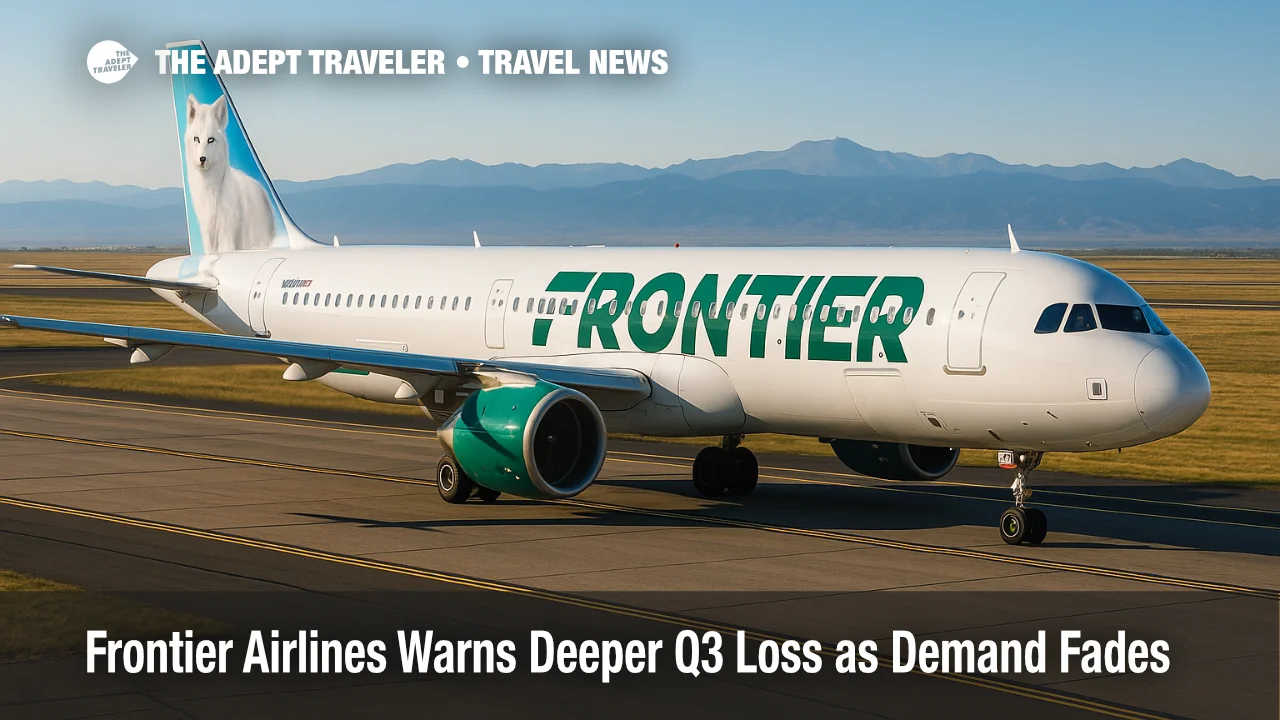Frontier Airlines warns deeper Q3 loss as demand fades

Frontier Airlines expects a wider third-quarter loss than analysts forecast after months of soft domestic demand and sluggish summer fares. The Denver-based budget carrier told investors it now sees an adjusted loss of $0.26 to $0.42 per share for Q3 2025, far steeper than Wall Street's $0.11 estimate, and will pare capacity through year-end to protect pricing power.
Key Points
- Why it matters: Budget travelers could face fewer nonstop options as the carrier trims flights.
- Travel impact: Reduced fall capacity, down three to five percent year over year, may tighten seat availability and blunt last-minute deals.
- What's next: Executives aim to restore profitability once household budgets stabilize and tariffs uncertainty eases.
- Summer weakness: Economy-class demand cooled despite peak-season promotions.
- Industry context: Frontier joined several U.S. airlines in withdrawing full-year guidance amid tariff-driven economic fog.
Snapshot
Frontier Group Holdings, the parent of Frontier Airlines, posted a second-quarter net loss of $70 million, or -$0.31 per share, on revenue of $929 million. Shares fell nearly nine percent after the carrier warned of an even tougher third quarter. Management said leisure travelers are booking closer to departure and paying lower fares, eroding yields in the price-sensitive economy cabin. To blunt the hit, Frontier will ground some frequencies this fall and focus on high-demand routes from Denver and Orlando. Chief Executive Barry Biffle told analysts he expects pricing momentum to improve as rivals also pull capacity and the tariff dispute shows signs of détente.
Background
Airlines have struggled to predict earnings since April 2025, when President Donald Trump's new tariffs spurred fears of slower growth. Frontier, Delta, American, JetBlue, and Southwest all retracted their annual profit forecasts, warning that higher import costs and cautious consumer spending were clouding demand. Domestic economy seats have been the hardest hit; lower-income households in particular have deferred discretionary trips. Frontier already trimmed flying in the June quarter, opting to preserve cash rather than chase volume with deep discounts. The airline ended Q2 with $766 million in liquidity, including $561 million in cash.
Latest Developments
Frontier Airlines Q3 loss forecast widens with new capacity cuts
Frontier told Tuesday's earnings call it will reduce system capacity by another three to five percent this autumn, echoing similar pullbacks announced earlier in the year. Executives argued that disciplined supply cuts should lift average fares, even if near-term revenue suffers. Market data compiled by LSEG show analysts had penciled in a $0.11 per-share loss before the update; the midpoint of Frontier's new range is four times that figure. The carrier is also deferring some Airbus A321neo deliveries into 2026 and accelerating the retirement of 15 older A320s to curb expenses. Reuters reports that domestic unit revenue has slipped roughly six percent year over year, underlining the pressure on low-cost operators.
Analysis
Frontier's guidance revision underscores how vulnerable ultra-low-cost carriers are to shifts in discretionary spending. While legacy airlines can lean on premium cabins and corporate contracts, budget carriers rely on volume to offset razor-thin margins. By cutting capacity, Frontier hopes to tighten the supply-demand balance and push yields higher, but fewer seats could frustrate travelers who depend on its rock-bottom fares. The move may also benefit rival Spirit Airlines, which competes on many of the same leisure routes but has indicated it will hold capacity steady. For investors, Frontier's cash position appears sufficient to weather several quarters of losses, yet sustained fare weakness could test that cushion, especially if fuel prices rise. Longer term, the airline's all-A321neo fleet strategy should lower unit costs and carbon emissions, positioning it well when demand rebounds. Travelers should watch for off-peak promotions as the carrier fills remaining seats, though the best deals may disappear earlier than usual given the planned flight cuts.
Final Thoughts
Frontier Airlines Q3 loss projections illustrate the strain that soft domestic travel demand and tariff-linked economic jitters are putting on budget carriers. Travelers eyeing cheap fares this fall may need to book sooner, as reduced capacity could limit last-minute bargains. The airline's response-tightening supply and deferring growth-mirrors industry trends aimed at shoring up yields until consumer confidence returns. For now, Frontier Airlines Q3 loss outlook remains a bellwether for the broader low-cost segment.
